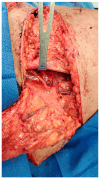Advances in Microsurgical Treatment Options to Optimize Autologous Free Flap Breast Reconstruction
- PMID: 39407732
- PMCID: PMC11477345
- DOI: 10.3390/jcm13195672
Advances in Microsurgical Treatment Options to Optimize Autologous Free Flap Breast Reconstruction
Abstract
Introduction: Reconstructive plastic surgeons have made great strides in the field of breast reconstruction to achieve the best results for patients undergoing treatment for breast cancer. As microsurgical techniques have evolved, these patients can benefit from additional treatment modalities to optimize the results of the reconstruction. Free tissue transfer from alternative donor sites for breast reconstruction is routinely performed, which was not possible in the past. Neurotization is now possible to address the numbness and lack of sensation to the reconstructed breast. For those patients who develop lymphedema of the upper extremity as a result of their breast cancer care, supermicrosurgical options are now available to treat and even to prevent the development of lymphedema. This study presents a narrative review regarding the latest microsurgical advancements in autologous free flap breast reconstruction. Methods: A literature review was performed on PubMed with the key words "autologous free flap breast reconstruction", "deep inferior epigastric perforator flap", "transverse upper gracilis flap", "profunda artery perforator flap", "superior gluteal artery perforator flap", "inferior gluteal artery perforator flap", "lumbar artery perforator flap", "breast neurotization", "lymphovenous bypass and anastomosis", and "vascularized lymph node transfer". Articles that specifically focused on free flap breast reconstruction, breast neurotization, and lymphedema surgery in the setting of breast cancer were evaluated and included in this literature review. Results: The literature search yielded a total of 4948 articles which were screened. After the initial screening, 413 articles were reviewed to assess the relevance and applicability to the current study. Conclusions: Breast reconstruction has evolved tremendously in recent years to provide the most natural and cosmetically pleasing results for those patients undergoing treatment for breast cancer. As technology and surgical techniques have progressed, breast cancer patients now have many more options, particularly if they are interested in autologous reconstruction. These advancements also provide the possibility of restoring sensibility to the reconstructed breast as well as treating the sequela of lymphedema due to their cancer treatment.
Keywords: DIEP flap; alternative donor sites; autologous free flap breast reconstruction; lymphovenous bypass; neurotization; vascularized lymph node transfer.
Conflict of interest statement
The author has no commercial associations or financial disclosures that may pose or create a conflict of interest with information presented in this article.
Figures
References
-
- Temple C.L., Tse R., Bettger-Hahn M., MacDermid J., Gan B.S., Ross D.C. Sensibility following innervated free TRAM flap for breast reconstruction. Plast. Reconstr. Surg. 2006;117:2119–2127. doi: 10.1097/01.prs.0000218268.59024.cc. - DOI - PubMed
-
- Temple C.L.F., Ross D.C., Kim S., Tse R., Bettger-Hahn M., Gan B.S., MacDermid J. Sensibility following innervated free TRAM flap for breast reconstruction: Part II. Innervation improved patient-rated quality of life. Plast. Reconstr. Surg. 2009;124:1419–1425. doi: 10.1097/PRS.0b013e3181b98963. - DOI - PubMed
-
- Chang E.I., Ibrahim A., Liu J., Robe C., Suami H., Hanasono M.M., Nguyen A.T. Optimizing quality of life for patients with breast cancer-related lymphedema: A prospective study combining DIEP flap breast reconstruction and lymphedema surgery. Plast. Reconstr. Surg. 2020;145:676e–685e. doi: 10.1097/PRS.0000000000006634. - DOI - PubMed
Publication types
LinkOut - more resources
Full Text Sources
Research Materials
Miscellaneous



